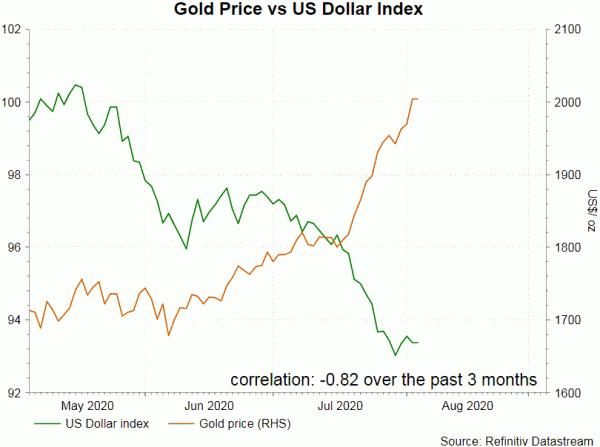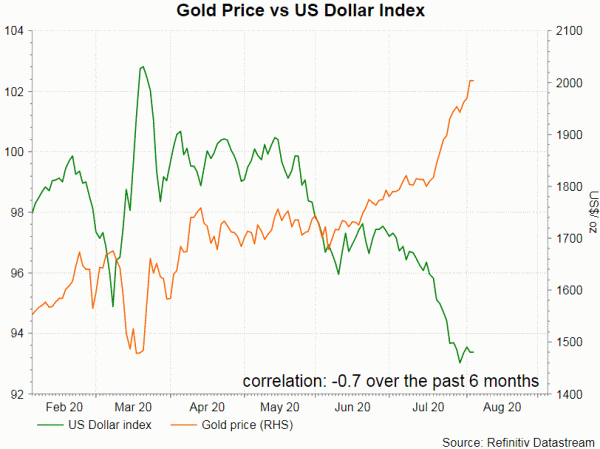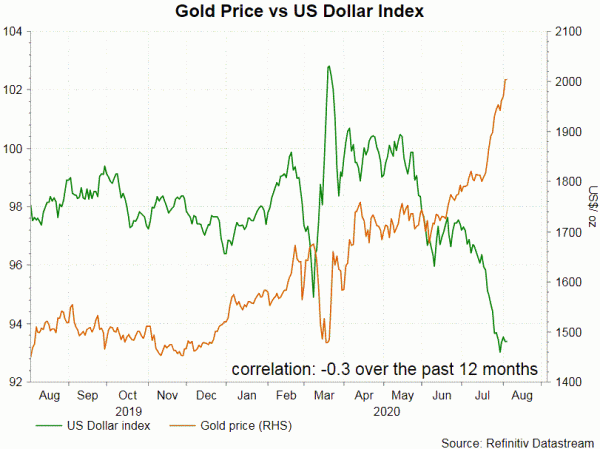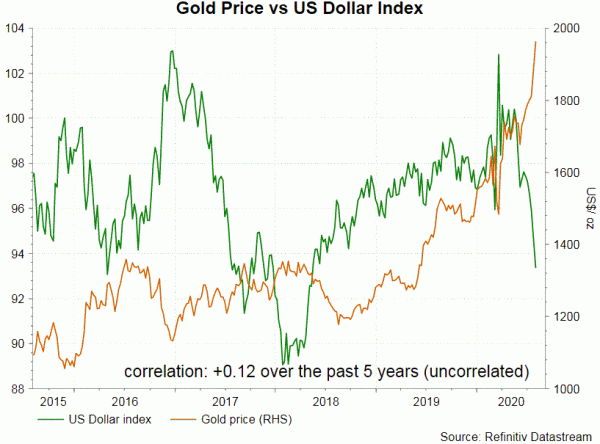Breaking yet another new record, gold price has surpassed psychological level US$2000/oz. As we mentioned in last week’s report, the key drivers for the rally are low real yields and rising inflation expectations. Weakness is US dollar is another driver for the yellow metal’s strength. However, the negative correlation between the two assets are not conventional. As both are traditional safe-haven assets, the two move at the same directions at times. The increasingly strong negative correlation over the past 3 months is a result of the diminishing confidence in US dollar as the world’s reserve currency.
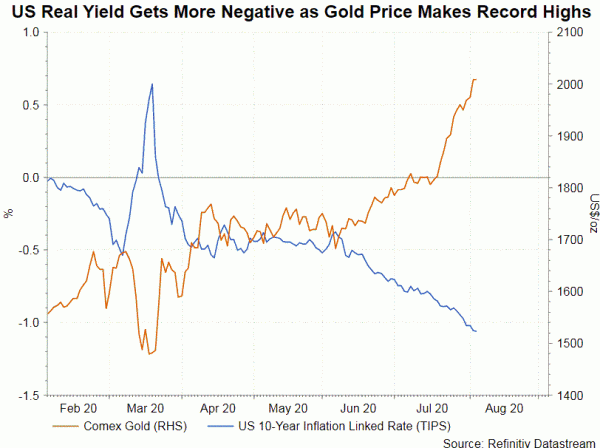 A more dovish Fed at that July meeting has sent yields lower. While leaving the policy rate and the QE program unchanged, it extended dollar repo and swap lines through to March 31, 2021. The policy statement revealed ongoing concerns about the coronavirus outbreak, the path of which will determine the pace of US and global recovery. At the press conference, Chair Powell affirmed that the central bank has “unlimited” measures to support the economy. He also noted that the Fed would “wrap up our deliberations in the near future”. These are hints that the Fed’s monetary policy framework will be changed in coming months. The market widely anticipates that the Fed will adopt an outcome-based forward guidance and shift to an average inflation target. These moves will effectively depress market rates. As the timing of the first rate hike is linked to inflation target and/or full employment, the market will expect the policy rate to stay at the record low level for the coming years (given the current subdued inflation and double-digit unemployment rate). Shifting to an average inflation target, from the point inflation target of 2%, signals that the Fed will be more tolerant of the overshooting of inflation above +2%. That is, the Fed could maintain monetary easing for some time after inflation has risen above +2%.
A more dovish Fed at that July meeting has sent yields lower. While leaving the policy rate and the QE program unchanged, it extended dollar repo and swap lines through to March 31, 2021. The policy statement revealed ongoing concerns about the coronavirus outbreak, the path of which will determine the pace of US and global recovery. At the press conference, Chair Powell affirmed that the central bank has “unlimited” measures to support the economy. He also noted that the Fed would “wrap up our deliberations in the near future”. These are hints that the Fed’s monetary policy framework will be changed in coming months. The market widely anticipates that the Fed will adopt an outcome-based forward guidance and shift to an average inflation target. These moves will effectively depress market rates. As the timing of the first rate hike is linked to inflation target and/or full employment, the market will expect the policy rate to stay at the record low level for the coming years (given the current subdued inflation and double-digit unemployment rate). Shifting to an average inflation target, from the point inflation target of 2%, signals that the Fed will be more tolerant of the overshooting of inflation above +2%. That is, the Fed could maintain monetary easing for some time after inflation has risen above +2%.
While inflation remains subdued, inflation expectations are climbing higher amidst ample liquidity in the market. Besides the Fed’s low rate policy and QE, the government has rolled out roughly US$3 trillion in coronavirus relief in four separate measures as of April. The White House has resumed talks on a new government relief package, including a possible extension of unemployment benefits. The size could be similar to the total of the previous 4 rounds.
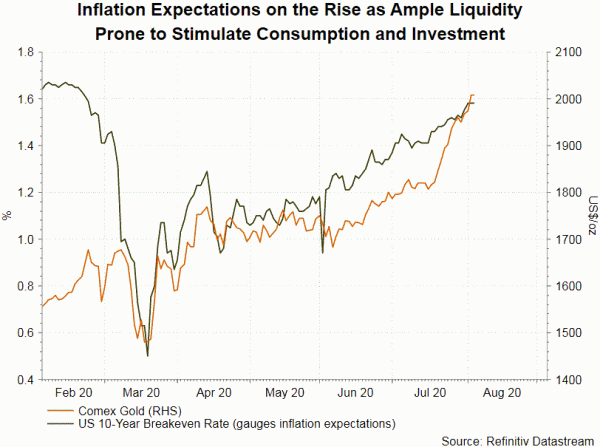 Expansionary monetary and fiscal policies are pressuring US dollar. While the former is causing the greenback to depreciate as a result of lower interest rates, the latter has triggered renewed concerns about the credibility of the currency in the long term. Indeed, Fitch has downgraded US outlook to “negative” from “stable”, while the trip A rating is affirmed. The rating agency projects that government debt will climb to 130% of GDP next year. As noted in the accompanying report, “high fiscal deficits and debt were already on a rising medium-term path even before the onset of the huge economic shock precipitated by the coronavirus… They have started to erode the traditional credit strengths of the US”.
Expansionary monetary and fiscal policies are pressuring US dollar. While the former is causing the greenback to depreciate as a result of lower interest rates, the latter has triggered renewed concerns about the credibility of the currency in the long term. Indeed, Fitch has downgraded US outlook to “negative” from “stable”, while the trip A rating is affirmed. The rating agency projects that government debt will climb to 130% of GDP next year. As noted in the accompanying report, “high fiscal deficits and debt were already on a rising medium-term path even before the onset of the huge economic shock precipitated by the coronavirus… They have started to erode the traditional credit strengths of the US”.
Over the past months, gold’s rally has been in tandem with US dollar’s weakness. This negative correlation has increased since the beginning of the year. Indeed, this correlation is not a typical one. Similar to gold, US dollar is also a safe haven asset as it is the world’s dominant reserve currency. This characteristic has made the assets move in the same direction at times. However, record low interest rates and huge debts are diminishing the greenback’s credibility, triggering debasement concern and reducing its safe haven demand. This explains why US dollar continues to depreciate gold breaks new records.




